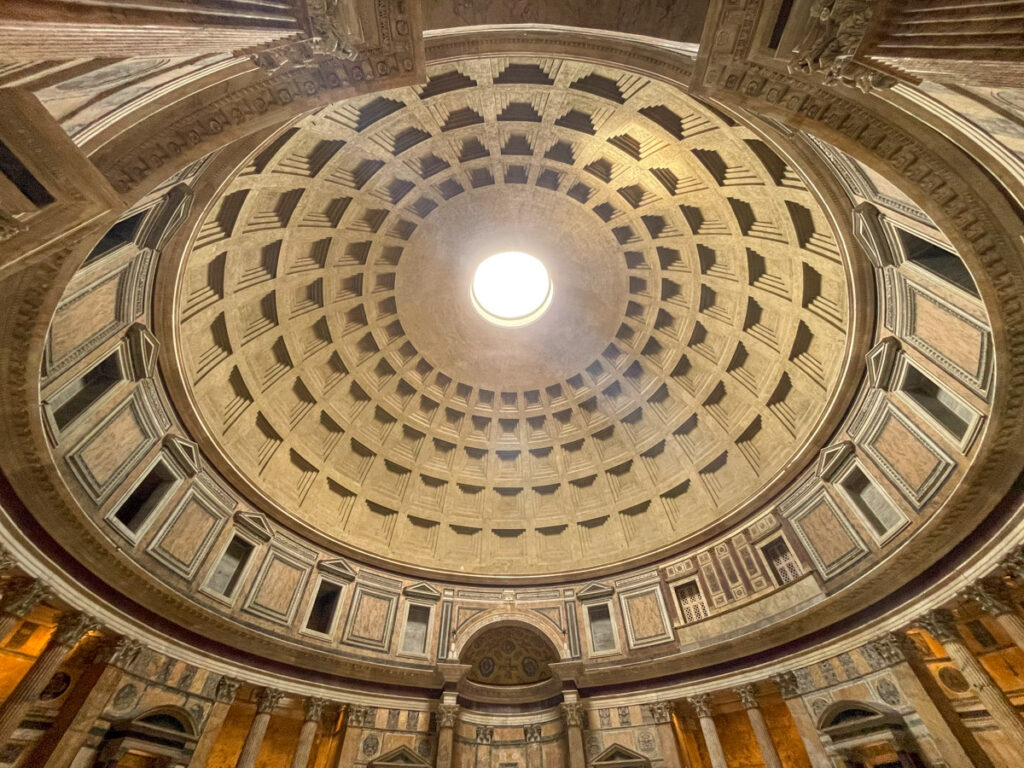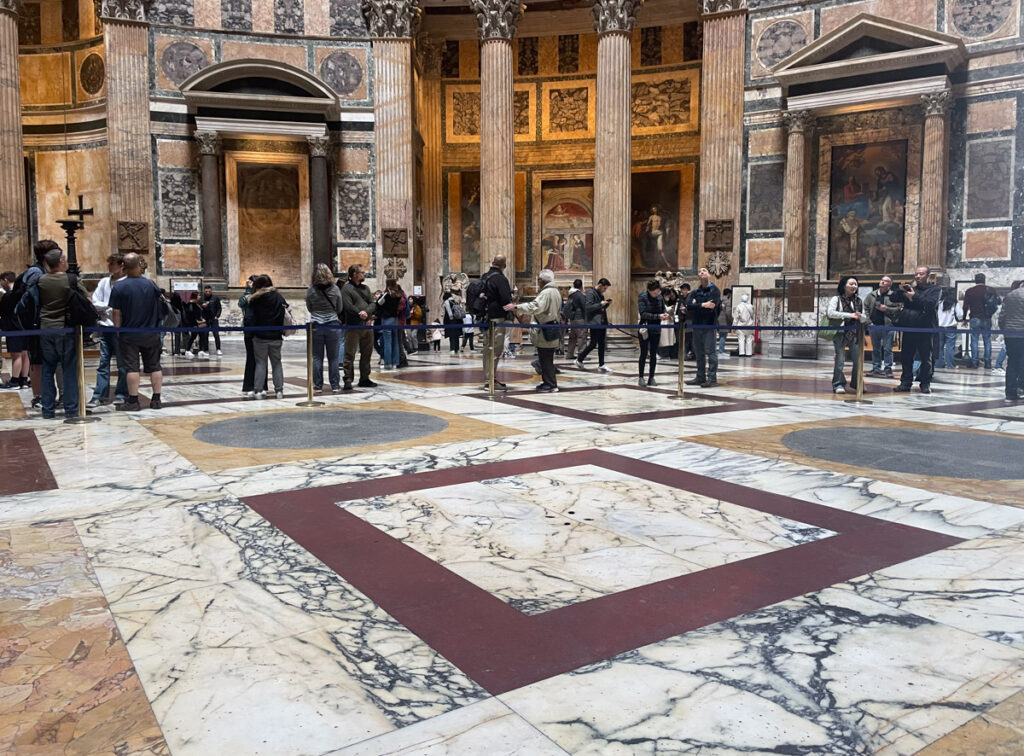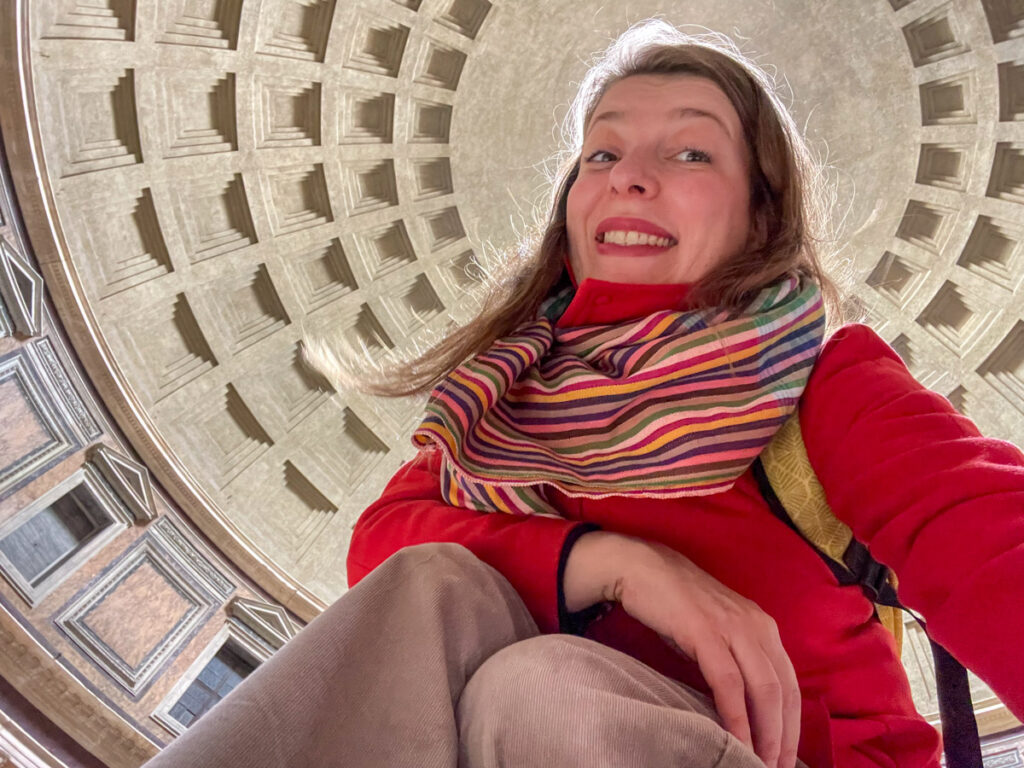Located in Rome, the Pantheon, now a Catholic church, is an architectural masterpiece that has stood the test of time. Its dome is the largest, unreinforced concrete dome in the world. This ancient temple is a must-see destination for anyone who loves history, art, and culture. In this blog post, you can discover the magnificence of the Pantheon in Rome.
Table of Contents
A Brief History of Pantheon
The Pantheon was initially built as a temple to all the gods in 27 BC by Marcus Agrippa. The word pantheon derives from the Latin word pan, which means ‘all’, and the word theos, ‘god’. However, it was destroyed by fire in 80 AD. The present structure that we see today was built by Emperor Hadrian in 126 AD. It has undergone many changes over the centuries, including being converted into a Catholic church in the 7th century.
PLAN YOUR TRIP TO ROME
Save money on entrance fees and transportation costs with the Roma Pass. This City Card offers free entry to two attractions, as well as discounts at other museums and archaeological sites, including the Colosseum, the Roman and Imperial Forums, the Capitoline Museums, the Ara Pacis and other must-see.
To stay connected in Italy, remember to buy an Airalo eSim online, with data and phone coverage for your trip to Rome.
The Architecture of Pantheon
The Pantheon is an architectural marvel designed with precision and engineering excellence. The temple is circular and features a portico of Corinthian columns supporting a triangular pediment.
The dome of the Pantheon is the largest unsupported dome in the world and the largest unreinforced concrete dome in the world. It measures 43.3 meters in height, which matches its width, giving it a sense of balance and harmony.
The thickness of the dome gradually decreases as it rises towards the top. Lighter volcanic materials such as pumice and tufa were used to minimise its weight. The ceiling coffers also helped reduce the weight and enhance the structure’s stability. At the top is an 8.7-meter circular opening called the oculus, which provides the only light source inside the temple.
The Pantheon’s interior is equally stunning, with beautiful marble walls and floors, intricate designs, and patterns on the dome. Adding to its historical significance, the Pantheon hosts the tomb of the famous Italian painter Raphael and some kings of Italy.

Things You Didn’t Know About the Pantheon
The Pantheon is undoubtedly an architectural marvel, but it also has many curiosities that you can only discover with a guided tour or audio guide. Here are some of them.
The Pantheon’s dome was once covered in bronze
The Pantheon’s dome was once covered in bronze, which would have made the city skyline shine in the sunlight. However, over time, the bronze was gradually removed and used elsewhere. Pope Urban VIII, who belonged to the Barberini family, famously took the bronze from the Pantheon’s portico to build cannons for the Vatican. It gave rise to the saying ‘quod non fecerunt barbari, fecerunt Barberini’, which means ‘what the barbarians did not do, the Barberini did’.
A demon created the Pantheon’s oculus
The architecture of the Pantheon is so ambitious that it does not seem possible that it was made by humankind, but it is divine. One legend has it that the oculus was created by a devil who ran away from the pagan temple when it was blessed and transformed into a Catholic church by Pope Boniface IV.
It cannot rain inside the Pantheon
It is not entirely true that it cannot rain inside the Pantheon. The oculus, the circular opening at the top of the dome, is actually open. However, most raindrops that enter the Pantheon are dissolved due to the chimney effect created by the dome’s shape. It also has a drainage system on the floor consisting of 22 drainage holes to deal with any water that may enter.

The Pantheon hosts some famous tombs
The Pantheon serves as the final resting place for many important individuals, such as the first two kings of unified Italy: Vittorio Emanuele II and his son Umberto I. Umberto’s wife, Queen Margherita of Savoy (for whom pizza margherita is named) is also entombed in the same area.
Additionally, the Pantheon host the tomb of the famous painter Raphael. After he died in 1520, Raphael was buried in a marble sarcophagus with a Latin inscription that reads, “Here lies Raphael, by whom nature feared to be outdone while he lived, and when he died, feared that she herself would die.”
The Pantheon inspired some famous movies
Rome’s impressive squares, monuments, fountains, museums, and churches have been the backdrop for many films and the subject of many more. The Pantheon, one of Rome’s most famous landmarks, has been featured in two well-known movies most visitors have likely watched: the classic Vacanze Romane and the thriller Angels and Demons.
In the movie Vacanze Romane, the cafe scene where Princess Ann (played by Audrey Hepburn) and Joe Bradley (played by Gregory Peck) meet his photographer friend Irving Radovich (played by Eddie Albert) for drinks was filmed on the right side of the Pantheon. Here, Radovich secretly takes photos of Princess Ann for an exclusive story Bradley plans to write for the newspaper he works for as a reporter.
In the novel and movie Angels and Demons, the protagonist Robert Langdon and his partner Vittoria go to the Pantheon to search for the Altar of Science. They believe that the Pantheon is the Altar of Science, where a Cardinal is due to be killed after following the first line in the poem: “From Santi’s earthly tomb with demon’s hole”. Santi is the last name of the famous Renaissance painter Raphael, whose tomb is inside the Pantheon. Langdon believes that the “demon hole” could have been the oculus. However, a local guide suggests a different interpretation.
The Pantheon influenced many other famous buildings’ architecture
The Pantheon is the best-preserved example of a monumental building from Ancient Rome. Its influence on Western architecture has been significant since the Renaissance period. This influence began with Brunelleschi’s 42-meter dome of Santa Maria del Fiore in Florence, completed in 1436.
Several notable versions of the Pantheon have been created since that time. These include the church of Santa Maria Assunta in Ariccia by Gian Lorenzo Bernini in 1664, Belle Isle House in England in 1774, and Thomas Jefferson’s library at the University of Virginia, The Rotunda, which was built between 1817 and 1826. Other structures inspired by the Pantheon include the Rotunda of Mosta in Malta in 1833 and the Nokia Church by architect Carl Ludvig Engel in 1837.
The Pantheon’s portico-and-dome form influenced the design of many buildings in the 19th and 20th centuries. This includes government and public buildings, city halls, university buildings, and public libraries, all of which echo the structure of the Pantheon.

Useful information to visit the Pantheon in Rome
Since July 2023, visitors can no longer enter the Pantheon for free. The ticket costs €5 and you can purchase it at the counter in front of the entrance. However, on the first Sunday of every month, entrance is free of charge, but there are usually long queues, so purchasing a ticket is better.
If you wish to enhance your experience, you can book a ticket with an audioguide for an additional cost of approximately €10. This will provide you with a better understanding of the architectural marvel. You can book your ticket online to skip the queue at the ticket counter.
If you have the budget, I highly recommend a guided tour. Having a live guide to tell you all the secrets of this ancient temple is undoubtedly a great opportunity to appreciate it even more.
How to Get to the Pantheon
The Pantheon is in Piazza della Rotonda, in the centre of Rome. You can get there by underground train, stopping at Barberini station on Line A or by bus. Just check on Google Maps for the best route from your position. If you get one of the hop-on hop-off bus in Rome, stop at Trevi Fountain, the nearest stop to the Pantheon.
Pantheon
Piazza della Rotonda
00186 Rome
Where to stay in Rome
I have tried several hotels in Rome during my travels and I recommend staying in the city centre to avoid the chaotic traffic of the capital. Among the hotels I suggest, the charming Roma Suites Navona has family rooms and is in a great location just a few steps from Piazza Navona.
If you prefer a hotel with a buffet breakfast, you can choose the Bloom Hotel Rome, very close to St Peter’s Basilica, while if you arrive by train, the best choice near Termini station is the DoubleTree By Hilton Rome Monti hotel with double and family rooms.
In conclusion, Pantheon is a testament to the brilliance of ancient Roman engineering and design. It is a must-visit for anyone who loves art, history, and culture. The temple has stood the test of time and continues to inspire visitors with its magnificence. Feel free to share your thoughts about the Pantheon.
